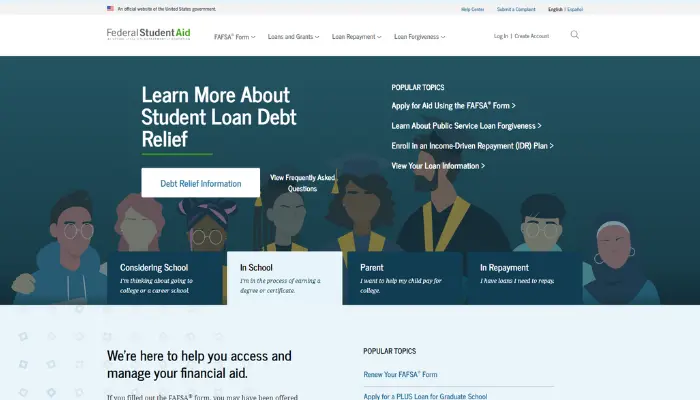Interest Rates on Student Loans: What You Need to Know
One of the unquestionably significant aspects of financing your education while in the United States is obtaining comprehensive knowledge about student loans.
Advertisements
You must have a clear understanding of the various alternatives and programs, such as loan forgiveness or income-based repayment plans.
Advertisements
Wisely choosing financial options is the main factor for effective money management. A detailed overview with valuable information about student loans includes the impact on your credit score and ideal debt management strategies. This is more ideal than any other form.
The use of loan consolidation and loan simulators has proven highly successful in simplifying the student loan management process. These two important tools greatly contribute to streamlining payments and helping you find smart approaches to your financial journey.
Advertisements
In this detailed roadmap of all facets of student loans, we offer not only practical advice but also high-value resources that will help you navigate the complicated waters of student loan financing.
With clear guidance and extensive information, this document serves as the definitive resource, giving you complete knowledge on how to prudently manage your student loans without doubts or fears.
Student Loan Forgiveness
Loan forgiveness is typically one of the main topics that come to mind regarding student loans. The Public Service Loan Forgiveness (PSLF) program is a prime example.
If you work for a government or nonprofit organization, this program involves forgiving the remaining balance of your loan after making 120 qualifying payments (which covers approximately 10 years).
Step-by-Step to Qualify for PSLF:
- Verify Employer Qualification: Ensure that your employer is a qualifying organization.
- Choose an Eligible Repayment Plan: Only income-driven repayment plans are eligible for PSLF.
- Make 120 Qualifying Payments: These payments must be made while you are working full-time for a qualifying employer.
- Submit the Employment Certification Form: It is recommended to submit this form annually or whenever you change employers.
Besides PSLF, there are other forgiveness programs, such as Teacher Loan Forgiveness, which can forgive up to $17,500 of debt for teachers who work in low-income schools for five consecutive years.
Income-Driven Repayment Plans

There are repayment plans that adjust the monthly payment amount based on income and family size. These are called income-driven repayment plans and help make payments more manageable. There are four main types: REPAYE, PAYE, IBR, and ICR.
Step-by-Step to Enroll in an Income-Driven Repayment Plan:
- Determine Your Eligibility: Check which plan is best for your financial situation.
- Gather Necessary Documents: You will need information about your income and family size.
- Complete the Application Form: This can be done online through the StudentAid.gov website.
- Submit Supporting Documents: Include copies of your tax return or other proof of income.
- Wait for Approval: Processing may take a few weeks.
Student Loan Interest Rates
Understanding student loan interest rates is fundamental. Interest rates can be either fixed or variable; typically, federal loans have fixed interest rates, while private loans can offer either option.
Factors Influencing Interest Rates:
- Type of Loan: Federal vs. Private.
- Credit History: For private loans, good credit can result in lower rates.
- Financial Market: Economic conditions can affect variable interest rates.
Student Loan Consolidation
By consolidating your loans, you can combine different federal loans into one, which can simplify your payments. This is done through a Direct Consolidation Loan.
Consolidation not only makes debt management easier by reducing the number of monthly payments but also can lock in a fixed rate for all your combined loans. It also opens up options for alternative repayment plans and forbearance benefits that may not have been available before, so keep this in mind for the future!
Consolidation is most beneficial for people with many federal loans, each with its own terms. It helps create one monthly payment, which reduces the risk of missed payments and makes financial management easier.
However, extending the repayment period may result in more interest accruing, leading to a higher total payment due.
Step-by-Step to Consolidate Your Loans:
- Gather Information About Your Loans: Include all the loans you want to consolidate.
- Choose a Loan Servicer: It can be the same current servicer or a new one.
- Complete the Consolidation Application: Available on the StudentAid.gov website.
- Select a Repayment Plan: Choose a plan that fits your financial situation.
- Submit and Wait for Approval: Processing may take a few weeks.
Student loan consolidation is an effective tool for simplifying debt management and potentially saving money in the long term. Evaluate all available options and consult a financial advisor if necessary.
Student Loan Simulators
A loan simulator is a tool that is essential for planning and managing the repayment of your debts. You can input your loan details and income information, and based on this, different payment scenarios will be shown, helping you make prudent financial decisions.
How to Use a Student Loan Simulator:
- Enter Loan Information: Provide the loan balance, interest rate, and repayment period.
- Add Income Details: Enter your annual income and other sources of revenue.
- Explore Different Repayment Plans: See how different repayment plans will affect your monthly payments and the total amount paid over time.
- Compare Scenarios: Adjust variables, such as income increases or changes in repayment plans, to understand the potential impact on your finances.
Student loan simulators can help you get a clear idea of how to better manage your debt and explore the payment options that best suit your financial situation. These tools are particularly useful for evaluating the impact that any changes will have on your future financial life, allowing you to think proactively.
Impact of Student Loans on Credit
Student loans can affect your credit in several ways. Making on-time payments can improve your credit score, while late payments or default can damage it.
Tips for Managing the Impact on Credit:
- Pay on Time: Setting up automatic payments can help avoid delays.
- Monitor Your Credit: Use credit monitoring services to keep track of your score.
- Communicate with Your Servicer: If you are facing difficulties, contact your loan servicer to explore options like deferment or forbearance.
Forgiveness Programs for Education Professionals
The Teacher Loan Forgiveness program offers forgiveness of up to $17,500 for teachers who work in low-income schools for five consecutive years.
Eligibility Criteria:
- Work in a Low-Income School: The school must be listed as a qualifying school.
- Teach Full-Time: You must have worked as a full-time teacher.
- Five Consecutive Years of Service: The years of service must be consecutive and complete.
Performance of Loans During Payment Suspension
During the pandemic, many federal student loans were suspended. This means that payments were not made and interest did not accrue. This action helped create temporary financial relief for many borrowers during an uncertain economic period.
Considerations About Payment Suspension:
- Impact on Credit: The suspension of payments does not negatively affect your credit score, as paused payments are treated as made on time.
- Planning for the End of Suspension: It is crucial to be prepared to resume payments when the suspension ends. Consider reviewing your budget and exploring repayment plan options that best suit your financial situation.
This period can be an opportunity for borrowers to readjust their financial planning, saving strategies for emergencies, or other high-interest debt payments.
It is also very important to stay alert to any notices from your loan servicer about when payments will restart and details on future actions.
Student Loan Calculators
Student loan calculators are essential tools to help manage and plan the repayment of your loans. They allow you to input your balances, interest rates, and income to calculate your monthly payments.
Step-by-Step Guide to Using a Student Loan Calculator:
- Enter Your Loan Information: Include balance, interest rate, and loan term.
- Add Your Income: Provide your annual income and other sources of revenue.
- View the Results: The calculator will show your monthly payments and the total amount paid over time.
- Adjust Variables: Test different scenarios to see how changes in income or repayment plans affect your payments.
Student Loan Debt Statistics
Student loan debt figures vary between states across the U.S. This variability alone suggests the scope of the problem, but these differences, significant as they are, allow us to recognize local trends and the economic impact related to student loans in different regions of the country.
Examples of Student Loan Debt Statistics:
- Delaware: The average student loan debt is $37,559, reflecting the considerable cost of higher education and its financial impact on graduates in this state.
- Florida: With an average of $38,459 in student debt, students in Florida face a significant financial burden that can influence their economic and career decisions.
- Georgia: With an average of $41,639 in student debt, Georgia exemplifies states where student loan costs are particularly high, increasing financial challenges for many graduates.
These numbers reveal uneven patterns of student loans among states, highlighting disparities in their economies. The data indicates some key areas where students are in extreme financial need, thus efforts should be made to develop programs offering debt relief.
The data is significant not only for equity in higher education funding but also for stakeholders who can find ways to minimize the impact of student debt—policymakers, educators, and financial institutions.
Navigating the complexities of student loans can sometimes seem complicated, but with the right knowledge and tactics, you can create a repayment strategy that brings financial stability to your life. Keep in mind that many others face comparable challenges.
If there is any area where you are unsure or lack information, do not hesitate to seek help from a financial specialist. This professional will provide personalized assistance, guiding you through alternative choices so that the decisions you make can improve your future financial well-being.





